In a summer transfer window that was expected to include a few big moves, no one would have predicted the speed at which some of these moves would occur. Chelsea have agreed to a deal to sign RB Leipzig’s Timo Werner after activating his buyout clause. This scout report will look to understand Werner’s style of play and how he fits into Chelsea’s tactics. Through tactical analysis, using data and footage, we will determine how he can improve Chelsea’s attacking style of play.
RB Leipzig system and Timo Werner’s role
Werner is a dynamic, eccentric centre-forward capable of playing as a lone striker or as part of a duo. Usually taking up the role of a complete forward, Werner is clinical and that is seen in his goal scoring exploits of 25 goals in the current Bundesliga season. His main attributes revolve around movement, space creation, positioning, and tactical flexibility. Werner has been instrumental to Leipzig’s attacking success and through this analysis, we will pinpoint the areas that illustrate his capabilities. The heat map gives us an indication of his movement and positioning this season, and we can see that he prefers coming in off the left.
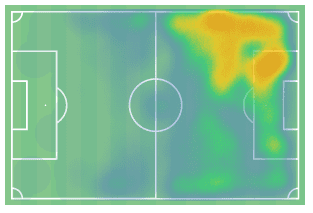
Before we dive into Werner’s strengths, it is important to take a closer look at the system he played in at RB Leipzig. RB Leipzig mainly utilised a 4-4-2 (27%) often switching to a 3-5-2 (17%) throughout the current season. The common theme here is the two-striker system that Julian Nagelsmann looked to implement. Werner played as part of the two and plays as the deep-lying forward and poacher. The fluidity of the front two allowed for unpredictability and kept the opposition’s defensive line guessing throughout the game. Leipzig rely on vertical passing to create space and chances, and Werner’s ability to find space in and around ‘zone 14’ is a major contributor towards this, pulling defenders towards him and creating space for his teammates.
Through quick passing combinations, Werner is able to play in the final ball or get on the end of a similar pass to unleash his lethal finishing. This pass map shows us the average positions of RB Leipzig’s players from a league game against Köln. We can see Werner (#11) is perfectly situated next to his strike partner on the left with the two full-backs playing high and wide. From here is where Werner makes his movements both vertically and horizontally.
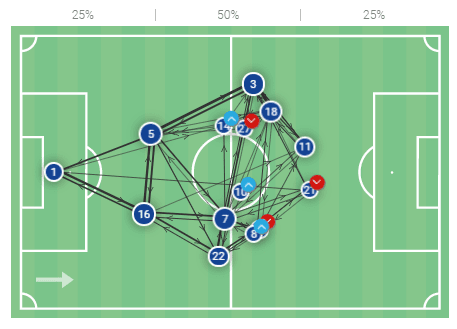
Link-up play
Werner is able to create space and link-up play through his passing and movement. The Leipzig striker is equally adept at dropping deep and getting on the end of through passes from his teammates. Looking at his statistics, Werner averages 2.54 passes to the final third with a 74.6% success rate. Even more so, he averages 3.91 in th penalty areawith a 56.9% success rate. Both of these statistics show that Werner is more than capable of becoming a playmaker and help unlock stubborn defences.
As we mentioned earlier, finding space and playing quick passes was part of the system employed at RB Leipzig and played to his strengths. Not only this, but Werner’s ability to drop deep gives Leipzig’s defence another passing option. His progressive play makes him an excellent option as most high pressing teams will not pick up his off the ball runs. Not only can he create space from the half-space but also makes diagonal runs to offset the oppositions’ defensive line to create confusion and an extra yard of space.
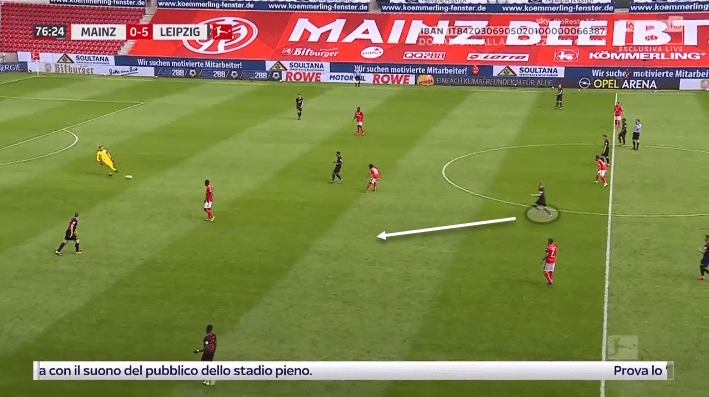
This example against Mainz is a prime example of Werner’s ability to link play. Here Werner drops deep into his defensive third to give Péter Gulácsi a passing option with Mainz pressing and marking their defenders high.
From here Werner is able to pick up possession and progress play forward having bypassed the first line of pressure.
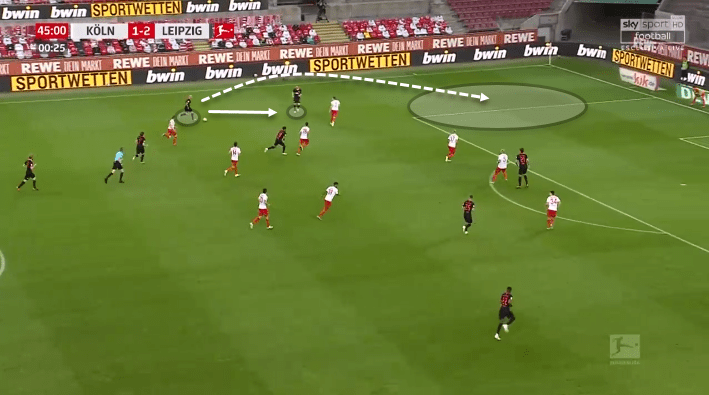
Another example can be seen here against Köln where Werner drifts out to the left side, receiving a pass from Angeliño. Werner’s movement brings his marker with him, opening space between the centre-back and full-back.
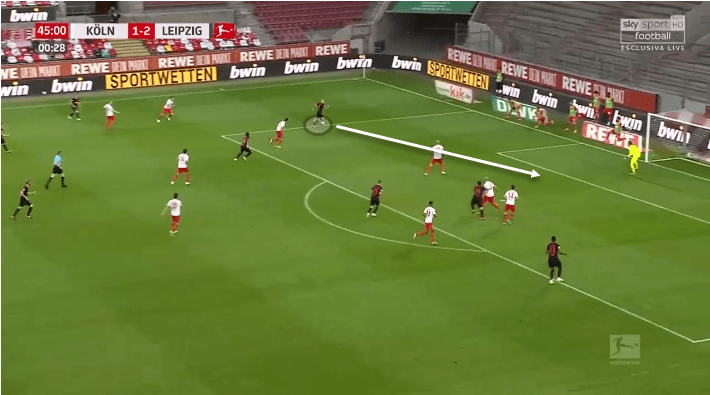
Werner holds up the ball long enough for Angeliño to make an immediate run after his pass. He saw the space when he received the initial pass and waited for the right moment to deliver the final pass. From here Angeliño is able to deliver a quick cross for Schick. We’ve seen this sort of movement between Mason Mount and Marcos Alonso on the left side for Chelsea and is something Werner will be comfortable within the Chelsea setup.
Attacking movement
A lot of Frank Lampard’s system is predicated on movement and quick decision making between the forwards. Werner’s spatial awareness and off the ball movements will be a good fit in Chelsea’s system. His ability both on and off the ball is exceptional and is what his main game is based around. Along with this, his movement through his dribbling and shot selection makes him one of the most dangerous forwards in world football.
These attributes contribute towards Werner’s playstyle as it is predicated on vertical movement and positioning through dropping deep and linking play which can lead to two results. Making runs into the channels to either create a shooting opportunity himself or play in an overlapping or underlapping runner and position himself in the 18-yard box into a goal-scoring position.
His movement can be unpredictable because of his ability to move towards the central areas or make his way into the channels at any time through his effective dribbling and shooting. Werner ranks first in most touches in the 18-yard box in Europe’s top 5 leagues this season combined with his 25 goals; this shows the effective decision making Werner has made in his games.
To further emphasise Werner’s dribbling, he has 6.24 dribbles per 90 minutes with a 51.1% success rate that has seen him rank 20th in Europe’s top 5 leagues this season. RB Leipzig rank 19th in progressive runs, citing the importance of Werner’s combined ability to connect play through his dribbling. Werner will often start on the left, drifting into the central areas and running at defenders when on the ball, moving on to either foot to deliver a cross or shot.
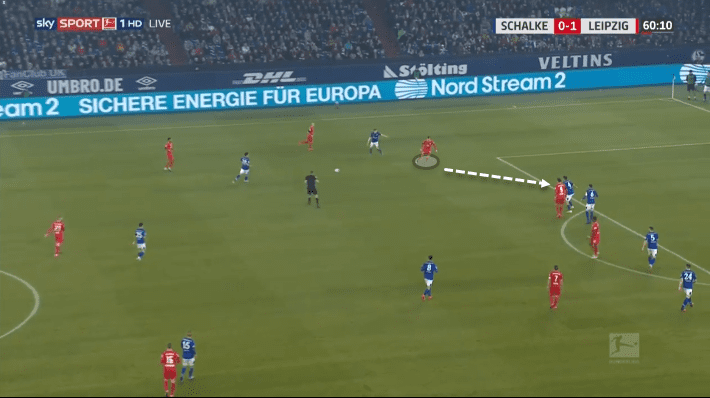
Here Werner is able to pick up possession in space and is able to drive forward into the box running at the defenders. Schalke’s defenders have left too much open space in the left channel for Werner to be able to dribble and get his shot away.
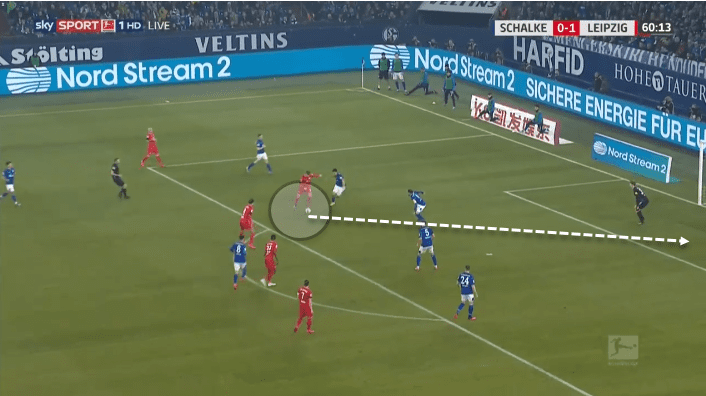
We can see here how no defender is close to him and despite there being four defenders, Werner is able to get his shot away.
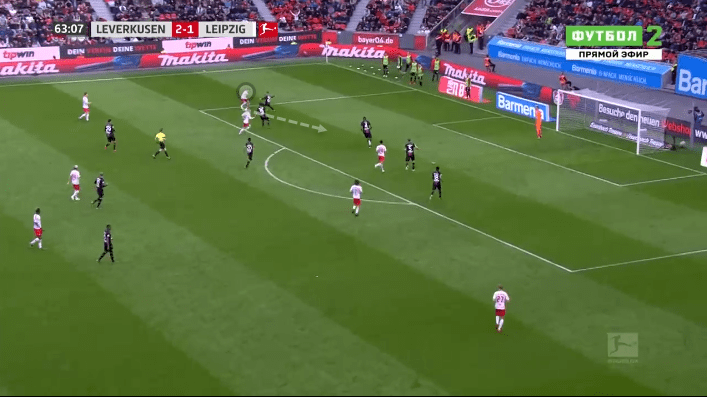
Alternatively, here we can see Werner pick up possession in a much smaller space, coming up against two defenders with three more in behind. This is where Werner can either hold up possession and pass back, dribble through or slide in a pass. He trusts his dribbling ability and manages to find a way through both players and get a shot away.
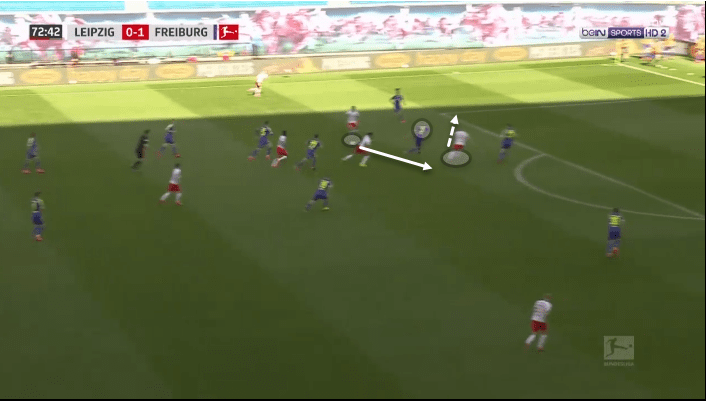
Werner is an intelligent centre-forward who is able to create space for himself and others around him through his decision making and movement. We saw through the earlier examples how Werner is able to create space through his link-up play but it was also his movement that opened up space. Similar to Roberto Firmino of Liverpool, Werner can create this space both on and off the ball effectively by dragging defenders out of position through intelligent runs.
Through a mixture of RB Leipzig’s system and Werner’s ability, defenders are pulled out of position just enough to open up shooting or passing opportunities. We can see an example of Werner’s movement and spatial understanding below. The central area is congested, however, there is still enough space to create a goal-scoring chance through the middle.
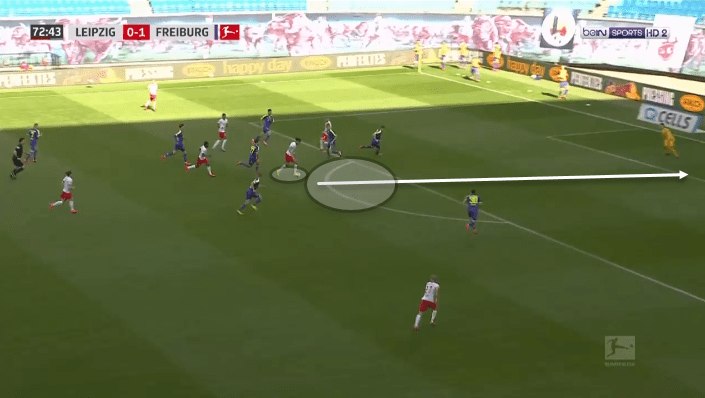
While the initial pass goes through to the left, Werner makes a similar movement and drags the central defender away. This allows the running midfielder space to run into and seize on the shooting chance. This is what gives Werner his playmaking and finisher tag in his complete forward role.
He’s able to pick up possession, connect passes between the thirds and finish. However, it is when he gets in between the lines that he is at his most dangerous, especially when he’s given an extra yard of space due to his extreme pace.
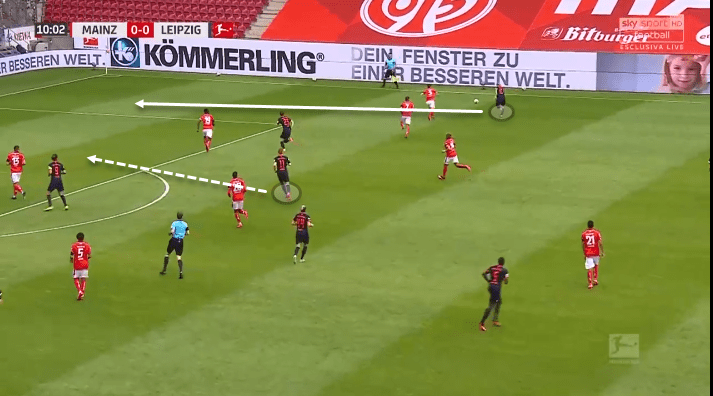
Werner’s understanding of space has heavily contributed towards his incredible goal tally. Knowing when to make runs and when not to has been a feature of his game this season.
As the example above shows, Werner playing in the number 10 position behind Yussuf Poulsen allows him time to make a decision and make a late run in the box. As Konrad Laimer makes a wide run down the flank, Werner waits patiently for the right time to move.
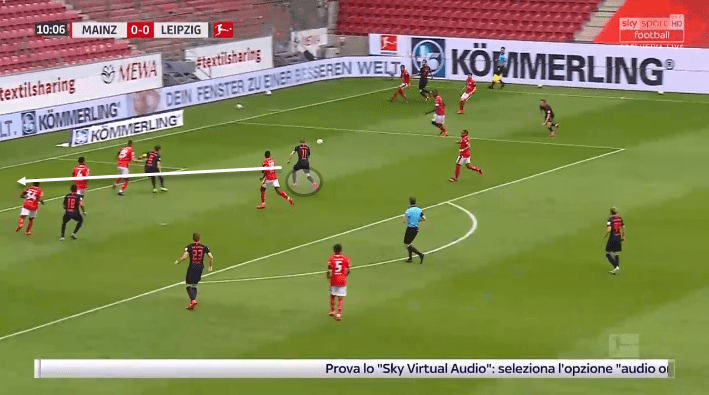
Werner’s perfectly timed run has allowed him to bypass oppositions markers, giving him all the space he needs to get on the end of the pass to take the shot. The late run isn’t picked up by the Mainz defenders thinking Laimer wouldn’t make it through. However, Werner’s calculated gamble pays off and results in a goal.
Chelsea & Timo Werner
Lampard’s Chelsea have a very fluid and attacking style of play. A possession hungry team, the current system revolves around a 4-3-3, but they have also used a 4-2-3-1 and 3-5-2. The use of different formations is to allow Lampard the flexibility to adapt to the opposition and not become predictable. However, their overall structure remains consistent throughout each system. Most of the players are centrally located and the full-backs are the widest players on the pitch in this 4-3-3 in the pass map below.
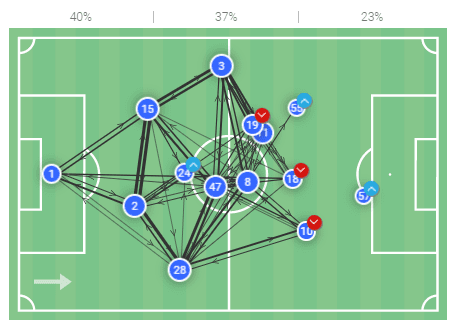
Typically, Kepa Arrizabalaga will play the ball out to the centre-backs who in turn will look forward to play into the attacking players. The dynamism of N’Golo Kante, Mateo Kovačić, and Mount allows Chelsea to become much more dynamic in midfield, allowing the forwards to make more off the ball movements to find space. The full-backs are tasked with playing high and wide, providing wide attacking and crossing options for Chelsea’s forwards. Often playing two attacking midfielders, the two players will look to drift into the central areas allowing for the overlapping runs of the full-backs.
Focusing on the centre-forward position, Lampard always looks to have his centre-forwards be as mobile as possible. The traits revolve around movement, link-up play, and spatial awareness. The striker will be expected to drop deep and link play by bringing in either the two wide players or onrushing central midfielder. Once they do this, they are expected to find space in the 18- yard box to get on the end of a potential goal-scoring opportunity. Werner excels at finding space both through his dribbling and passing abilities.
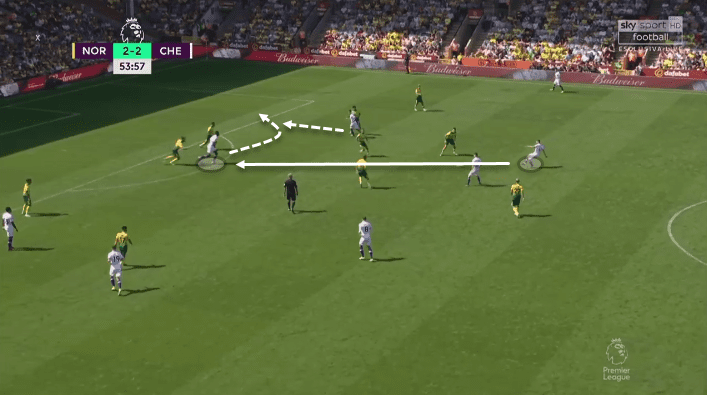
Chelsea often struggled to break down low-block defences and had to rely on persistence and most often the movement combinations of the forward players where the striker was key. Here Tammy Abraham is marked by two centre-backs. Jorginho sees Barkley in a good position and instead of playing a direct pass that could be intercepted, he finds Abraham who drops deep and plays in a quick through ball for Barkley to open up space in behind the two centre-backs.
Additionally, because Chelsea’s forwards need to be mobile and play both a deep-lying forward role and poacher role, being able to get on the end of long passes is also critical. This is especially important when Chelsea play on the counter-attack. The Abraham goal against Arsenal stands out as a perfect goal. Playing as a poacher requires pace and anticipation and Werner’s ability in both is obvious and would give Lampard an extremely potent option against more open teams.
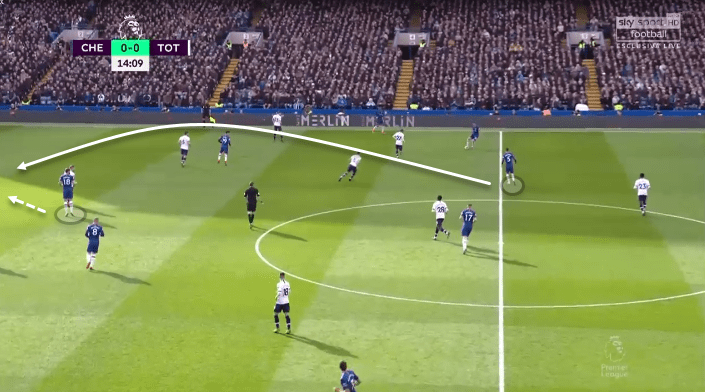
Here against Tottenham Hotspur, we can see Jorginho receives a pass and immediately sends a through ball into the vacant space for Giroud to run into. The next frame sees Giroud make a movement before Jorginho receives the pass, watching him. This also shows the understanding that the players have developed. While this example resulted in a goal, Werner’s movement would be much quicker and be able to lose his marker much easier. Chelsea’s creativity and link-up play between the forwards will only increase and become much more sophisticated.
The addition of Hakim Ziyech is an exciting prospect and the sight of both Werner and Ziyech has the potential to produce the displays that Diego Costa and Eden Hazard produced for Chelsea.
Out of possession
Chelsea’s out of possession tactics include a high pressing system. Werner is an excellent presser of the ball and his pace allows him to counter-press effectively. Giroud or Abraham along with the two supporting forwards will look to press. Werner’s off the ball movement will be an asset to Chelsea and his incredible work rate is a perfect match.
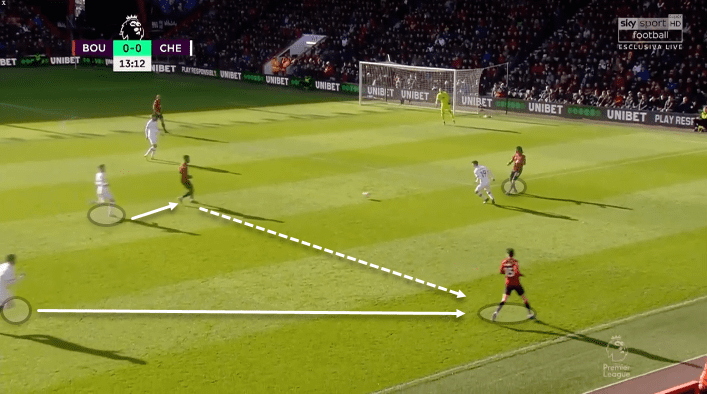
This example shows Chelsea’s high pressing against Bournemouth as they try to play out from the back. It starts with Giroud pressing the lone centre-back who is then forced to pass out wide. This triggers Mount to press Nathan Ake and Barkley the next ball receiver. Chelsea’s press has forced the ball to be played out wide where James is coming to join the press. The right-back successfully intercepts the pass and puts Chelsea on a very quick counter-attack. Werner has averaged 2.2 defensive duels per 90 with a 61.29% success rate, showing he can slot into the system and contribute off the ball.
Will there be a change in system for Frank Lampard?
However, one of the issues that we can see here is Werner’s preference to play in a two. Chelsea haven’t paired two strikers together and even in their 3-5-2 will often play an attacking midfielder in behind Abraham or Giroud. Lampard signing Werner could also be an indication to want to have more tactical options and playing a version of a 4-4-2 could be on the horizon. Pairing up Abraham and Werner could represent an interesting option with both players able to play the role Lampard wants.
Similar to the Werner-Schick combination, Abraham could focus on finding space in the penalty area with Werner playing around him. This could, however, affect how Chelsea fit in their abundance of attacking midfielders, but it certainly gives Lampard options. The quick, agile nature of Chelsea’s attacking structure means that Werner could play as the sole striker up front. The movement of Barkley, Mount, and Pulisić means Werner will be involved in numerous positional exchanges which are in line with his overall play style.
Conclusion
Overall, I believe Werner will be an excellent addition to Chelsea’s attacking lineup. Throughout this analysis, we’ve mentioned his key strengths with regards to Chelsea’s system, but it shouldn’t also be forgotten that his clinical finishing abilities are one of his key assets that result in goals. When you analyse the overall picture, it’s easy to see why Chelsea and Lampard moved quickly to secure his signature.






Comments